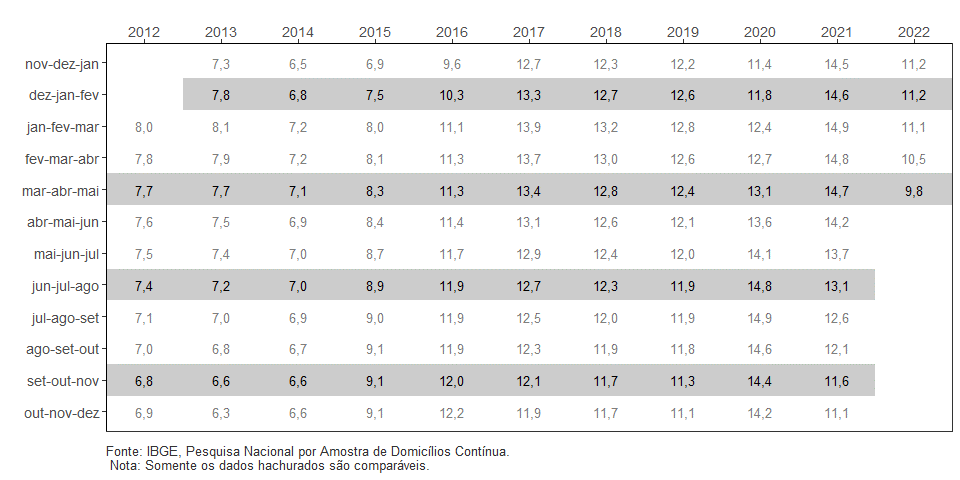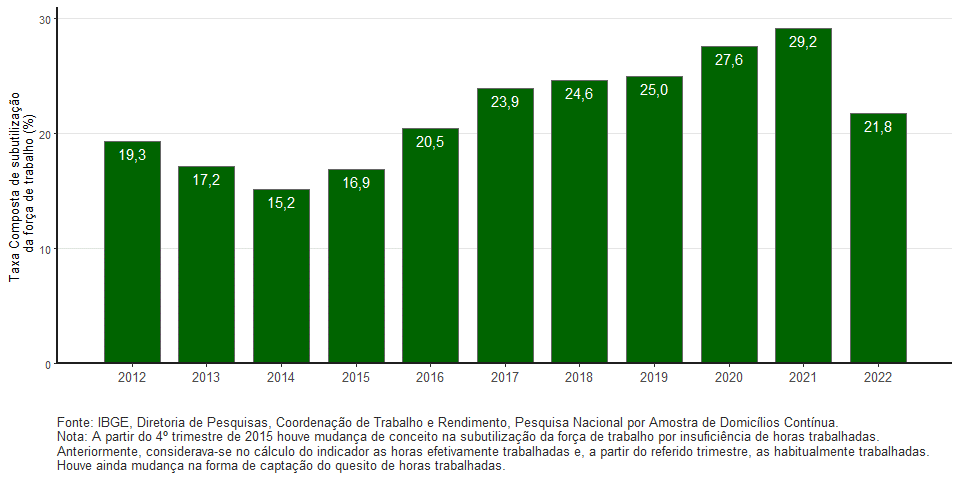Continuous PNAD: unemployment rate is 9.8% and underutilization rate is 21.8% in quarter ended in May
June 30, 2022 09h00 AM | Last Updated: June 30, 2022 10h01 PM
The unemployment rate (9.8%) of the moving quarter between March and May 2022 dropped 1.4 percentage points (pp) in relation to the quarter from December 2021 to February 2022 (11.2%) and 4.9 pp against the same period of 2021 (14.7%). This is the lowest unemployment rate for a quarter ended May since 2015, when it was 8.3%. The unemployed population (10.6 million persons) reduced 11.5% (1.4 million less persons) over the previous quarter and 30.2% (4.6 million less persons) in the annual comparison.
| Indicator/Period | Mar-Apr-May 2022 | Dec-Jan-Feb 2022 | Mar-Apr-May 2021 |
|---|---|---|---|
| Unemployment rate |
9.8% | 11.2% | 14.7% |
| Underutilization rate |
21.8% | 23.5% | 29.2% |
| Usual real earnings |
R$ 2,613 | R$2,596 | R$ 2,817 |
| Change of the usual real earnings over: | Stable | -7.2% | |
The number of employed persons (97.5 million) was a record in the time series started in 2012, with a high of 2.4% against the previous quarter and of 10.6% (9.4 million more persons) against the same period of 2021. Estimated at 56.4%, the employment-population ratio - percentage of employed persons in the population at working age - grew 1.2 pp against the previous moving quarter (55.2%) and 4.9 pp over the same quarter of 2021 (51.4%).
The compound underutilization rate (21.8%) fell 1.7 percentage points in relation to the quarter of December 2021 to February 2022 (23.5%) and 7.4 pp in comparison with the quarter ended April 2021 (29.2%). It is the lowest rate for the quarter since 2016 (20.5%). The underutilized population (25.4 million persons) dropped 6.8% (1.8 million less persons) over the previous quarter (27.3 million) and 23.8% (7.9 million less persons) in the annual comparison.
The time-related underemployed population (6.6 million) stood stable against the previous quarter and decreased 11.1% in the year (827 thousand less persons).
The population outside the labor force (64.8 million persons) dropped 0.8% (506 thousand less persons) over the previous quarter and 4.7% (3.2 million less persons) in the annual comparison.
The discouraged population (4.3 million persons) reduced 8.0% (377 thousand less persons) over the previous quarter and 22.6% (1.3 million less persons) in the annual comparison. The percentage of discouraged persons in the labor force (3.9%) fell 0.4 pp against the previous quarter and 1.3 pp against the same quarter a year ago.
The number of workers with a formal employment contract in the private sector (except domestic workers) was 35.6 million persons, having increased 2.8% (981 thousand persons against the previous quarter and 12.1% (an increase by 3.8 million persons) in the annual comparison.
The number of workers without a formal labor contract in the private sector (12.8 million persons) was the highest n the series. This figure increased 4.3% compared to the previous quarter (523 thousand more persons) and 23.6% (2.4 million persons) in the year.
The number of self-employed workers (25.7 million) remained stable in relation to the previous quarter, yet it rose 6.4% (1.5 million more persons) in the year.
The number of domestic workers (5.8 million persons) remained stable compared with the previous quarter, but rose 20.8% (995 thousand persons) in the year.
The number of employers (4.2 million persons) grew 4.1% compared to the previous quarter (168 thousand persons) and 16.2 (590 thousand persons in the annual comparison.
The number of employees in the public sector (11.6 million persons) grew 2.4% compared to the previous quarter and stood stable in the annual comparison.
The informality rate was 40.1% of the employed population (or 39.1 million informal workers) against 40.2% in the previous quarter and 39.5% in the same quarter of 2021.
The usual real earnings (R$2,613) stood stable over the previous quarter and fell 7.2% in the year. The usual real wage bill (R$249.8 billion) grew 3.2% over the previous quarter and 3.0% in the annual comparison.
Unemployment rate - Brazil - 2012/2022

Estimated at 108.1 million persons in the moving quarter of March to May 2022, the labor force (employed and unemployed persons) increased 0.8% (897 thousand persons) in comparison with the quarter from December to February and increase of 4.6% (4.8 million persons against the same quarter last year. It was the greatest number of persons in the labor force of the time series started in 2012.
The following activity groups rose against the previous moving quarter: General Industry (2.5%, or 312 thousand more persons), Construction (2.9%, or 210 thousand more persons), Trade, repair of motor vehicles and motorcycles (1.5%, or 281 thousand more persons), Transportation, storage and mailing (4.6%, or 224 thousand more persons), Lodging and food (3.6%, or 186 thousand more persons), Information, Communication and Financial, Real Estate, Professional and Administrative Activities (2.8 %, or 311 thousand more persons), Public administration, defense, social security, education, human health and social services (2.8%, or 466 thousand more persons) and Other services (3.7%, or 182 thousand more persons). The other groups did not post any statistically-significant change.
Against the quarter ended May 2021, increases were observed in: General Industry (11.0%, or 1.3 million more persons), Construction (13.2%, or 866 thousand more persons), Trade, repair of motor vehicles and motorcycles (15.3%, or 2.5 million more persons), Transportation, storage and mailing (14.0%, or 629 thousand more persons), Lodging and food (26.9%, or 1.1 million more persons), Information, Communication and Financial Activities, Real Estate, Professional and Administrative (4.0%, or 449 thousand more persons), Public administration, defense, social security, education, human health and social services (3.6%, or 580 thousand more persons), Other services (20.7%, or 878 thousand more persons) and Domestic services (20.4%, or 990 thousand more persons). The other groups did not record significant changes.
Composite underutilization rate - Quarter from March to May - Brazil - 2012 to 2022 (%)

As to usual real average earnings (R$ 2,613.00) over the previous moving quarter, all groups had stability. In the annual comparison, there was increase in the category of Transportation, storage and mailing (6.1% or R$146) and reduction in the groups: Industry (6.9%, or R$ 184), Information, Communication and Financial, Real Estate, Professional and Administrative Activities (7.1%, or R$ 283) and Public administration defense, social security, education, human health and social services (13.3%, or R$ 567).
Among the employment types, in comparison with the previous moving quarter, there was an increase in the category of Workers without a formal contract (6.0% or R$101). The other categories did not record significant changes. In the comparison with the quarter from March to May of 2021, there was no growth in any of the categories.

